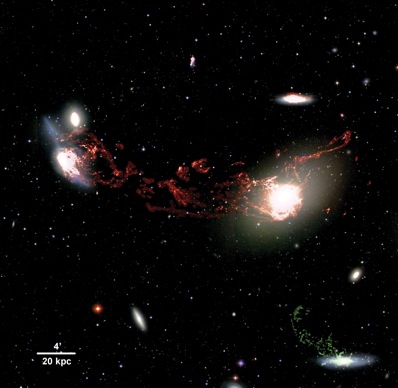|

Top Stories

|

|
 |
 |
 

Cosmic eye peers into distant galaxy
...astronomers have peered into the heart of a young star-forming region in the distant Universe as it appeared only two billion years after the big bang...
read more

A multi-wavelength portrait of stellar birth
...by combining observations at different wavelengths from telescopes on the ground and in space, astronomers have taken a fresh look at the history of star formation in a galaxy residing in the Small Magellanic Cloud...
read more

Mars Odyssey enters new orbit for extended mission
...NASA’s orbiting Mars Odyssey spacecraft has been given the go ahead for a third two-year extension of its mission to survey the red planet, making it the longest serving of six spacecraft currently studying Mars...
read more |
 |
 |

|
Spaceflight Now +

|

|
 |
 |

Subscribe to Spaceflight Now Plus for access to our extensive video collections!
 How do I sign up? How do I sign up?
 Video archive Video archive

STS-120 day 2 highlights

Flight Day 2 of Discovery's mission focused on heat shield inspections. This movie shows the day's highlights.

 Play Play

STS-120 day 1 highlights

The highlights from shuttle Discovery's launch day are packaged into this movie.

 Play Play

STS-118: Highlights

The STS-118 crew, including Barbara Morgan, narrates its mission highlights film and answers questions in this post-flight presentation.

 Full presentation Full presentation
 Mission film Mission film

STS-120: Rollout to pad

Space shuttle Discovery rolls out of the Vehicle Assembly Building and travels to launch pad 39A for its STS-120 mission.

 Play Play

Dawn leaves Earth

NASA's Dawn space probe launches aboard a Delta 2-Heavy rocket from Cape Canaveral to explore two worlds in the asteroid belt.

 Full coverage Full coverage

Dawn: Launch preview

These briefings preview the launch and science objectives of NASA's Dawn asteroid orbiter.

 Launch | Science Launch | Science

 Become a subscriber Become a subscriber
 More video More video

|
 |
 |

|
|
 |

Galactic collisions could halt star formation
BY KULVINDER SINGH CHADHA
ASTRONOMY NOW
Posted: October 13, 2008
High-speed collisions between galaxies could give them enough energy to stop their gas clouds condensing into stars, offering an alternative explanation to supermassive galactic black holes stripping away gas, say a team of astronomers from Yale University who present their work in the November 2008 issue of Astrophysical Journal Letters.
“Galaxy-galaxy velocities are high (around 1,000 to 2,000 kilometres per second) in clusters of galaxies, because of the large mass and gravitational attraction of the cluster as a whole. The main reason M86 and NGC 4438 had a high velocity collision is because they are in a cluster,” says Professor Jeffrey Kenney, lead author of the paper.

The high-speed collision between M86 and NGC 4438 could help identify more modest examples, and thus provide clues on the extent of galactic collisions on star formation. Image: Tomer Tal and Jeffrey Kenney/Yale University/NOAO/AURA/NSF.
Using a wide field mosaic imager at Kitt Peak Observatory, Kenney’s team observed 400,000 light year-long filaments of ionised hydrogen gas connecting together the galaxies M86 and NGC 4438 in the Virgo Cluster. The two galaxies are of the elliptical and spiral type, respectively. Most galaxies of the elliptical variety experience gas accretion and mergers in this way.
"Our data show that this particular system represents the nearest recent collision between a large elliptical and a large spiral galaxy,” says Kenney. “This discovery provides some of the clearest evidence yet for high-speed collisions between large galaxies, and it suggests that the consequences of such collisions are a plausible alternative to black holes in trying to explain the mystery of what process turns off star formation in the biggest galaxies."
Two years ago a team from Oxford used ultraviolet data from GALEX (Galaxy Evolution Explorer) to find evidence of why large galaxies seem to have very few young stars: central galactic black holes grow in size until they heat up and expel much of the galaxy’s interstellar gas. New stars can’t then form. Though this seems counterintuitive, star formation can only occur when cold hydrogen gas condenses into clumps. If the gas has too much energy, that can’t happen. Both collisions and black holes can be the cause.
The problem is that the largest galaxies are the ones that would tend to experience high-speed collisions due to their greater, mutual gravitational pull. But they are also the ones with the largest black holes. So how can you separate the effect of one from the other?
“The way to separate the heating effects of gravitational interactions from those of active galactic nuclei/black holes is to study galaxies with and without nuclear activity,” says Kenney, stating that all ellipticals probably have large, central black holes. However, not all black holes are fed by a galaxy’s interstellar gas, so not all galactic nuclear regions radiate much energy. “M86 has an extremely weak active centre, so the central black hole can't be responsible for much in that case. In some ellipticals which have strong active centres, the heating seems to be important. But it remains unclear how important the two heating effects are for the entire galaxy population.”
|
 |
 |
 |
|
|



